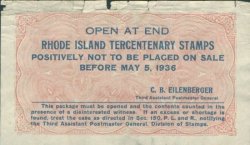![]()
Organization
& Contacts
![]()
Membership
![]()
Events & Schedule
![]()
RI Postal History
![]()
Return to RIPHS
Main Page
The Rhode Island Tercentenary
Issue
By Thomas E. Greene
October 1996
Part I Part II Part III Part IV Part V Part VI Part VII Part VIII
|
In anticipation of this momentous issue, a group of Rhode Island collectors and dealers decided to try and get cancels from the 115 RI post offices that existed in 1936. The only official first day cover cancel was the one issued in Providence dated May 4, 1936. All other covers with other town/city cancellations are designated as unofficial. An article in Stamps publication circa 1936 stated that RI had 109 post offices, but when counting all offices including ship, railroad, branches, stations and military post offices, the list grows to 115. In addition to examples of the 115 RI post offices, there are variations on some of these. The following examples show some of the known variations. The Providence Post Office used four different cancellations. There was a Universal Machine Cancel, two hand cancels - 65 mm for blocks and 22 mm for single stamps and a CDS with a three in it. Neither Arctic or Phenix issued cancellations. However, there exists covers from each post office canceled West Warwick, but with Arctic and Phenix written on the back. I have not included these post offices in the master list because the hand written name could not be considered a cancellation in the 20th century. Both of these offices were contract stations and did not have canceling devices in 1936. |
Part I Part II Part III Part IV Part V Part VI Part VII Part VIII
Copyright 2003© all rights reserved
by RIPHS
Contact
Webmaster

